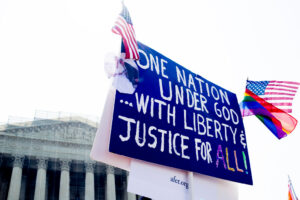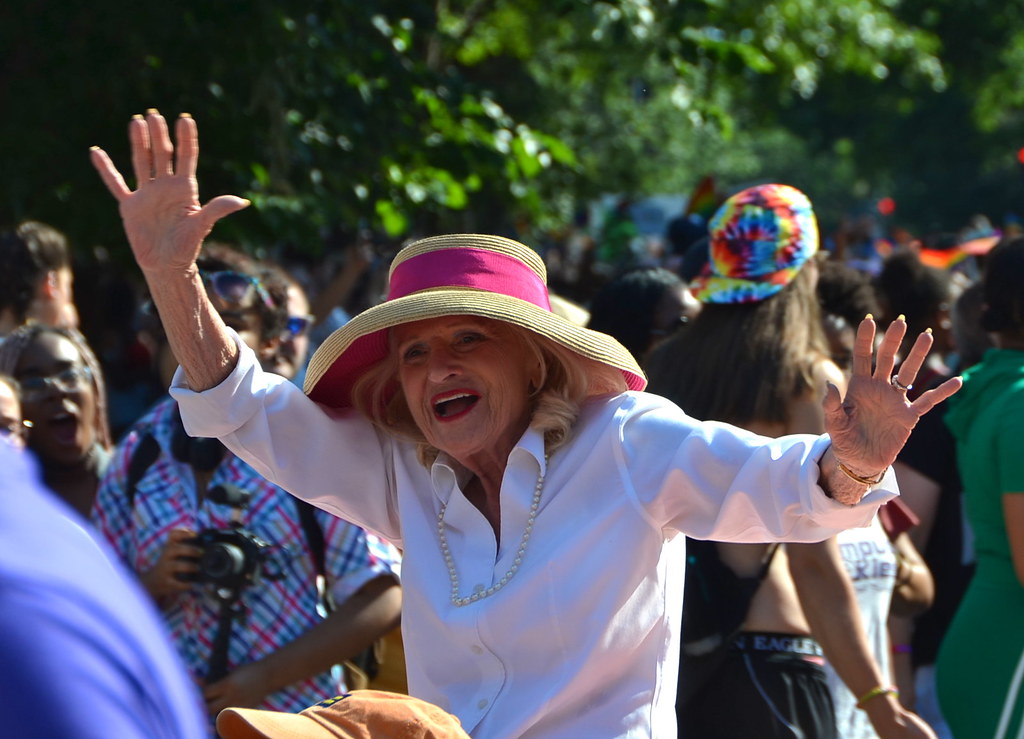On February 5, 2009, Thea Spyer died from multiple sclerosis, completely changing the course of her life partner Edith Windsor’s life. Days after the passing of her life partner, Edith was hit with a $360,000 tax bill to the federal government and a $275,000 tax bill to the state of New York. This was due to the dubious nature of gay marriages under the law at the time which, in essence, was not recognized. The actions Edith Windsor took next set her on a path that led to one of the most significant court rulings in American history, the overturning of the Defense Of Marriage Act, otherwise known as DOMA.
Edith and Thea met for the first time in 1965 at a restaurant named Portofino in New York. They would later spend the whole night in each other’s company, dancing, and later leaving for a friend’s apartment. Despite the clear connection and attraction, the two would not pursue any kind of relationship during this first encounter. It wouldn’t be until two years later, on a Memorial Day weekend in the Hamptons, when they met again for the second time, that something more substantial would blossom between the two. This was the beginning of a more than forty-year partnership between the two that tragically ended with the death of Thea Spyer in 2009.1

Following Thea Spyer’s death, the IRS sent Windsor a $360,000 federal tax bill. The federal government felt that Edith Windsor owed this money to the IRS because of an estate tax that comes into effect when assets are transferred to another person.2 However, for spouses, there is what’s called a “marital deduction trust,”3 which allows for an unlimited amount of assets to be transferred untaxed. All married individuals have access to this trust. However, in 2009, homosexual marriages were not recognized by the federal government. Therefore, since technically Edith Windsor and Thea Spyer weren’t married, they did not have access to this trust. This made it so that when Thea died and her assets were transferred to Edith, Edith was stuck paying the tax on the totality of the estate that she gained from her dead partner. Unfortunately, Edith had to pay the tax bill. She later filed a lawsuit in 2010 saying that the Defense of Marriage Act discriminated unfairly against homosexual relationships.4
The struggles Edith Windsor faced were apparent on day one. She had immense difficulty even finding an attorney who would represent her in court. The first time she sought out an attorney, she went to a place where she thought she could get help, namely, to the gay rights organizations that were prominent at the time. She hoped she could acquire one of their backings; however, reality proved to be far less simple. The organizations did not agree to help Edith. They were worried that she was too privileged to be the face of this issue. They thought that because of this, the public would be even less inclined to sympathize with Edith’s plight than what would be usually assumed. However, despite the setbacks and the sting of rejection, Edith did not give up.5 It was only a little later that Edith would find her champion in Roberta Kaplan, whom she met from “a friend of a friend.”6 It was Roberta Kaplan who would represent Edith all the way up to the Supreme Court, along with the help of several other co-counselor attorneys.
Now that Edith Windsor had her attorneys, she could finally file her lawsuit against the government, which she did on November 9, 2010. Her legal strategy was centered around the equal protection clause, which stated that every person had a right to equal protection under the law.7 Windsor’s case argued that her treatment, because of the Defense of Marriage Act, was in violation of the equal protection clause because it unfairly denied privileges to one subsection of the population.8 A year later, in 2011, the Obama administration concluded that section 3 of the Defense of Marriage Act was, in fact, unconstitutional under the equal protection clause. This conclusion, however, did not do much to actually change the Defense of Marriage Act. That was still up to the courts. Following the Biden administration’s conclusion, the Republican leadership in Congress attempted to intervene in the case, vowing to uphold the Defense of Marriage Act. However, this did nothing to stop Edith’s momentum. Following the Republican leadership’s announcement, in February 2012, U.S. District Court Judge Barbra Jones ruled that the Defense of Marriage Act was unconstitutional. This ruling was not the only one. Similar court cases were already going through the judicial process, and at the time that Judge Barbra Jones made her ruling, she was joined by four other district court judges who ruled similarly. This was a huge victory for Edith Windsor but, unfortunately, the ruling at the district level was not enough. The ruling was later appealed to the Second Circuit. Edith and her attorneys made their arguments once more in the courtroom but, this time, it was to the court of appeals. The court of appeals upheld the ruling of Judge Barbra Jones, also finding that section 3 of the Defense of Marriage Act was unconstitutional. However, again the case was appealed and, this time, it was appealed all the way up to the Supreme Court, which announced they would hear the case on December 7, 2012. This would be the very last time this case was in court.9

To provide some legal context, Edith Windsor’s court case was appealed twice. An appeal happens when one side, the prosecution or the defense, believes that a judge’s ruling was wrong. If an attorney wishes for the same case to be heard again, it must be appealed to a higher court. This is due to an American right that frees us from double jeopardy, which is when someone is prosecuted twice for the same crime.10 This is why a court case must be appealed if it is to be heard again. However, even then, it is not the same judge that hears the case nor is it even the same court. In fact, there is a completely different level of courts for these appealed cases. They are called the court of appeals and they are in circuits. Furthermore, it is not easy to get a case appealed because it is the Court of Appeals’ place to say whether or not they find a case worth hearing. From here, it is possible to appeal a case again if an attorney is still unsatisfied with the ruling. This time, however, there are no more courts of appeals for the case to be heard in. In this scenario, the case goes to the Supreme Court but, just like the Court of Appeals, the Supreme Court decides whether or not a case is worth hearing. This system is in order to stop an influx of relatively unimportant cases from flooding high-level courts. It is also a way of retaining the integrity of a judge’s ruling and the judge’s legal authority. Once a case reaches the Supreme Court, it is at the highest level of court in the country. The ruling of the Supreme Court trumps all other courts and can only be refuted by a combined effort of the President and Congress. In other words, once the Supreme Court hears a case, it can never be heard again.11

On June 26, 2013, the Supreme Court ruled that section 3 of the Defense of Marriage Act was unconstitutional. With that one ruling, federal law was officially changed. This marked the final end of the United States v. Windsor case four years after Thea Spyer’s passing. The legal battle was long and hard, starting with the horrible passing of Edith’s life partner. From there, Edith struggled to take the first step towards justice, inhibited by the lack of help she expected from allied organizations. After she found her attorneys, she filed her lawsuit and won. But, just when Edith thought she had victory in her grasp, reality dragged her back down. The case was appealed and then appealed again for the second time until it got to the Supreme Court where the Defense of Marriage Act was promptly overturned. In the end, Edith Windsor was given a tax refund but, not just that. Edith Windsor, in her massive, triumphant victory over her oppressors, changed America forever. Starting from that point, the movement for gay rights was unstoppable. It was because of Edith Windsor’s effort in this case that the landmark court case Obergefell v. Hodges even had a leg to stand on. Because of Edith Windsor, homosexual relationships are now seen as equal to heterosexual relationships under the law.
- “Thea Spyer and Edith Windsor,” The New York Times, May 27, 2007, sec. Fashion, https://www.nytimes.com/2007/05/27/fashion/weddings/27spyer.html. ↵
- Robert D. McFadden, “Edith Windsor, Whose Same-Sex Marriage Fight Led to Landmark Ruling, Dies at 88,” The New York Times, September 12, 2017, sec. U.S., https://www.nytimes.com/2017/09/12/us/edith-windsor-dead-same-sex-marriage-doma.html. ↵
- “Marital Deduction Trust,” LII / Legal Information Institute, accessed November 30, 2023, https://www.law.cornell.edu/wex/marital_deduction_trust. ↵
- “United States v. Windsor (Challenging the Federal ‘Defense of Marriage Act’) | New York Civil Liberties Union | ACLU of New York,” January 24, 2011, https://www.nyclu.org/en/cases/united-states-v-windsor-challenging-federal-defense-marriage-act. ↵
- Eliza Gray, “Person of the Year Runner-Up: Edith Windsor,” Time, December 11, 2013, https://poy.time.com/2013/12/11/runner-up-edith-windsor-the-unlikely-activist/print/. ↵
- Ariel Levy, “Edith Windsor’s Gay-Marriage Milestone,” The New Yorker, September 23, 2013, https://www.newyorker.com/magazine/2013/09/30/the-perfect-wife. ↵
- “Equal Protection,” LII / Legal Information Institute, accessed November 30, 2023, https://www.law.cornell.edu/wex/equal_protection. ↵
- “Windsor v. United States,” American Civil Liberties Union (blog), accessed November 30, 2023, https://www.aclu.org/cases/windsor-v-united-states. ↵
- “United States v. Windsor (Challenging the Federal ‘Defense of Marriage Act’) | New York Civil Liberties Union | ACLU of New York,” January 24, 2011, https://www.nyclu.org/en/cases/united-states-v-windsor-challenging-federal-defense-marriage-act. ↵
- “Double Jeopardy,” LII / Legal Information Institute, accessed November 30, 2023, https://www.law.cornell.edu/wex/double_jeopardy. ↵
- “Appeals | United States Courts,” accessed November 30, 2023, https://www.uscourts.gov/about-federal-courts/types-cases/appeals. ↵


